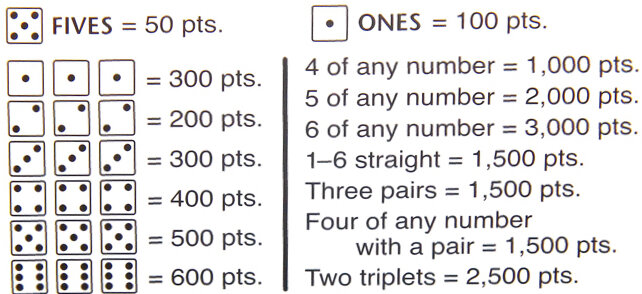Farkle: Dice Game
Get ready to roll into the world of Farkle, where I'll teach you the ins and outs of scoring, strategy, and how to claim victory in this addictive dice game.
Farkle is not just a game of chance; it's a thrilling blend of strategy and luck that brings friends and families together for unforgettable moments.
Its simplicity makes it easy to learn, yet the strategic depth keeps players engaged for hours, fostering competition and camaraderie.
The exact origins of Farkle are unknown, but the game is believed to date back to the mid-1980s.
It has since spread globally, primarily due to its easy-to-learn rules and the minimal equipment required, making it accessible to players of all ages.
Learning to play Farkle effectively can turn an ordinary evening into a lively and exciting social event, making it a popular choice for game nights worldwide.
In this comprehensive guide to Farkle, we will delve into everything you need to know to master the game, from the basic rules and scoring combinations to advanced strategies that will give you a competitive edge.
We'll explore various game variations and provide insights into playing Farkle both in-person and online, ensuring you're well-equipped no matter where you play.
Farkle Video Tutorial
Basic Rules of Farkle
Equipment Needed
To play Farkle, all you need is six dice, a flat surface, and a score sheet to keep track of the points.
How to Start the Game
To start a game of Farkle, each player rolls one die, and the highest roller gets the first turn. The game then proceeds clockwise around the table.
The Objective of Farkle
The object of the game is to score the most points by rolling different dice combinations with six dice.
Once a player scores 10,000 or more points, each other player gets one more turn to try and win.
Farkle Point Combinations
The Game Play
In Farkle, a single turn begins with the player rolling all six dice.
After each roll, the player must set aside at least one scoring die or combination (such as a 1, which scores 100 points, or a 5, which scores 50 points; other combinations like three of a kind or a straight have their own scoring values).
The player then decides whether to "bank" the points accumulated so far during the turn and pass the dice to the next player, or continue rolling the remaining dice that weren't set aside to score additional points.
However, if a roll results in no scoring dice being thrown, it's called a "Farkle," and all points for that turn are lost. After a Farkle, the dice pass to the next player.
The strategy comes from knowing when to risk continuing to roll for more points and when to stop and bank the points to avoid losing them by rolling a Farkle.
If a player scores with all six dice in a turn, they can choose to roll all six dice again to accumulate more points in the same turn, potentially boosting their total score significantly.
Winning the Game
The end of a game in Farkle begins when a player reaches a predetermined score, commonly set at 10,000 points, during their turn.
Once this score is reached or surpassed, each remaining player gets one final turn to try and beat the leading score.
The winner is the player who has the highest score after these final rounds are completed.
Farkle is more fun with weighted, satisfying dice. These sets make every roll feel epic - perfect for gifts or treating yourself!
🎲 Luxury Dice Sets 🎲
| Type | Product | Experience | |
|---|---|---|---|
| ⚡ Metal | Heavy Stainless Steel Dice | Makes a *clink* sound like casino chips | View |
| 🔶 Brass | Antique-Finish Dice Set | Develops a vintage patina over time | View |
| 💧 Liquid Core | Glitter-Filled Resin Dice | Mesmerizing swirl with every roll | View |
(As an Amazon Associate I earn from qualifying purchases)
Additional Rules
Some game variations require players to reach a minimum score (such as 500 points) in a single turn before they are allowed to start banking their points on the score sheet.
Once dice are set aside for scoring in a turn, they cannot be combined with dice rolled in subsequent throws to form new scoring combinations.
Understanding Scoring Combinations
Single Ones and Fives:
One (1): Scores 100 points.
Five (5): Scores 50 points.
Three of a Kind:
Three 1s: 300 points.
Three 2s: 200 points.
Three 3s: 300 points.
Three 4s: 400 points.
Three 5s: 500 points.
Three 6s: 600 points.
Straights:
1-2-3-4-5-6: A straight of one through six scores 1,500 points.
Three Pairs:
Any three pairs: For example, 2-2, 3-3, 4-4. This combination scores 1,500 points.
Two Triplets:
Any two sets of three of a kind: For example, 2-2-2 and 5-5-5. This combination scores 2,500 points.
Four of a Kind:
Four of any number: Scores 1,000 points.
Five of a Kind:
Five of any number: Scores 2,000 points.
Six of a Kind:
Six of any number: Scores 3,000 points. This the highest scoring single roll outcomes in Farkle.
Strategies and Tips
For beginners playing Farkle, mastering a few basic strategies can greatly enhance your gameplay and enjoyment of the game.
A fundamental approach is to prioritize safety over risk, especially when you're just starting. Aim to bank your points regularly rather than risking them for potentially higher scores.
Initially, focus on accumulating points with single ones and fives if no other combinations are available, as these are more frequent and less risky.
As you become more comfortable with the scoring, start to recognize when you might strategically go for three of a kind, particularly with higher numbers like fours, fives, and sixes, which score more.
Always be cautious with your dice rolls; if you've scored with most of your dice and only one or two remain, consider banking your points to avoid the risk of a Farkle, which would lose all points for that turn.
By consistently applying these practices, you'll develop a better feel for when to take risks and when to secure your score, setting a solid foundation for more advanced strategies as you gain experience.
For those looking to refine their Farkle strategy, advanced tactics focus on maximizing scores while effectively managing risk.
Analyzing the probability of scoring with remaining dice becomes crucial; for instance, if you have scored with three dice and are left with three non-scoring dice, the odds are favorable to roll again.
Another advanced strategy involves setting specific target scores for each turn before banking, based on your position relative to other players; if you're leading, you might bank earlier to consolidate your lead, whereas if trailing, you might take more risks.
Additionally, paying close attention to other players' scores and strategies can offer insights into when to play conservatively or aggressively.
By balancing these approaches, advanced players can more effectively navigate the delicate balance between risk and reward, pushing their scores higher while managing the threat of a Farkle.
Variations of Farkle
10,000: The standard goal is to reach 10,000 points, but this target can be adjusted higher or lower depending on player preference or regional tradition.
Farkle with Penalty Points: In some variations, rolling a Farkle can result in a penalty, such as subtracting 500 or 1,000 points from the player's total score.
Welfare Farkle: When a player Farkles, they contribute a set amount of points (like 500) to a central pot, which can be claimed by the next player who rolls a straight 1-6 or scores over a certain amount in one turn.
Piggybacking: Allows players to start their turn using the non-scoring dice left by the previous player, adopting the risk but potentially increasing the reward.
Dynamic Dice: The number of dice rolled changes based on certain conditions met during the game, such as a player scoring above a certain threshold.
Increasing Minimum Score: Some games require an increasingly higher minimum score to "get on the board" with each round.
Team Farkle: Players can form teams, with members taking turns rolling but sharing a common score, which can alter strategies regarding risk and reward.
Tournament Rules: Often feature specific modifications like timing constraints, elimination rounds, or unique scoring rules designed to add competitive pressure and distinction to standard play.
5 Dice Farkle: In this version, players roll five dice instead of the usual six, which means fewer potential scoring combinations but also quicker rounds and tighter decision-making. Add a full house (3 of a kind + a pair) combination to the scoring combinations for 1,500 points.
Online Farkle
Online Farkle provides a convenient and accessible way for enthusiasts to enjoy the game from the comfort of their homes or on the go.
Various gaming platforms offer digital versions of Farkle that can be played against AI opponents or live players from around the world, complete with chat functions, leaderboards, and customizable rules.
This online version ensures that players can find a game at any time without the need for physical dice or score sheets.
Comparing online and traditional gameplay, several differences emerge.
Traditional Farkle relies on physical interaction, which enhances the social experience, allowing for body language cues and direct conversation. It creates memorable, tactile experiences with the dice, which many players enjoy.
In contrast, online Farkle makes setup and play quicker and easier, automates scorekeeping, and broadens the player base, connecting you with opponents across diverse skill levels and geographical locations. However, it may lack the personal touch and the charm of handling physical dice.
Online games often include features like timers to keep the game moving, which can change the pace compared to more leisurely in-person sessions.
Both formats have their unique appeals and can be chosen based on convenience, preference for social interaction, and availability of players.
Let the Farkle Games Begin!
With a deeper understanding of Farkle's rules, strategies, and variations, it's time to put your newfound knowledge to the test and dive into the exhilarating world of dice-rolling excitement.
Gather together your friends and family, set up your Farkle game set, and embark on thrilling rounds of strategic decision-making and competitive fun.
Whether you are aiming for the highest score, strategizing to outwit your opponents, or simply enjoying the camaraderie of game night, Farkle offers endless entertainment for players of all ages and skill levels.
So roll the dice, take calculated risks, and let the adventure begin—Farkle awaits!
Frequently Asked Questions
-
To win at Farkle, players aim to be the first to reach or exceed a predetermined score threshold, typically set at 10,000 points.
Players accumulate points by rolling scoring combinations with the dice and then choosing whether to continue rolling for additional points or bank their current score.
The player with the highest score after the final round is declared the winner.
-
In Farkle, rolling five of the same number on the dice constitutes a "5 of a kind" and scores 2,000 points. This is one of the highest-scoring single-roll combinations in the game and can significantly boost a player's score.
-
Farkle and Yahtzee are similar dice games but have distinct differences. While both games involve rolling dice to score points, Farkle focuses more on risk management and strategic decision-making, allowing players to choose which dice to set aside and when to stop rolling.
Yahtzee, on the other hand, is more structured, requiring players to achieve specific combinations like full houses and straights to score points.
-
In traditional Farkle, six dice are used. However, variations of the game exist, including versions played with five dice, which offer a faster-paced and slightly different gameplay experience while retaining the core mechanics and objectives of the game.
-
Playing Farkle with 5 dice follows the same basic rules as the traditional game but with some adjustments to accommodate the reduced dice count.
Players take turns rolling five dice, aiming to score points by forming scoring combinations such as ones, fives, three of a kind, and straights.
The game proceeds with players deciding whether to continue rolling for more points or bank their current score.
The first player to reach or exceed the target score threshold, typically 10,000 points, wins the game.
DISCLAIMER: This page contains affiliate links, which means that if you click on one of the product links, I’ll receive a small commission at no extra cost to you. Thank you for your support!










